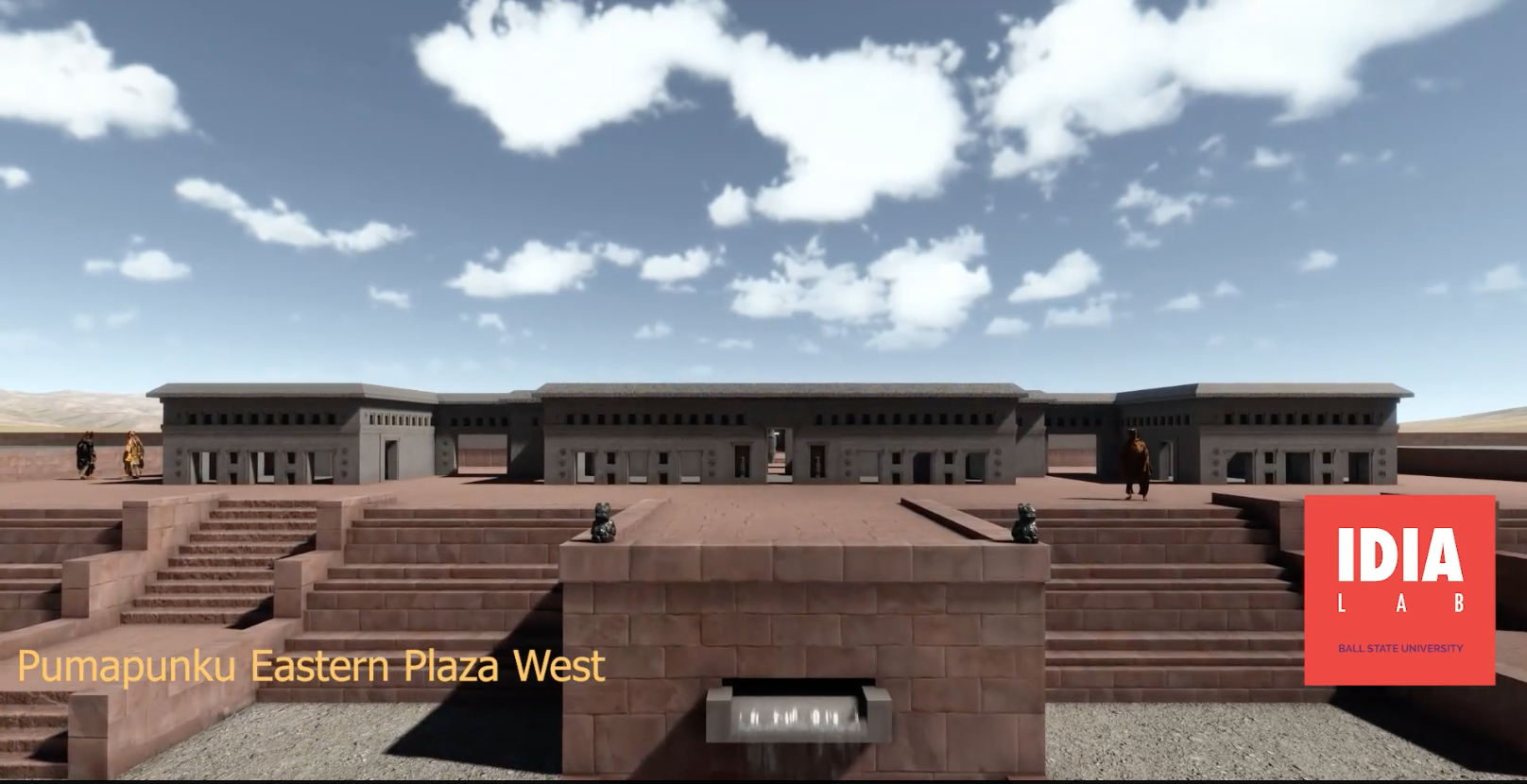
Pumapunku Reconstruction
There’s something fascinating about looking at ancient ruins and imagining what the lives and culture might have been like of the people who lived there. With the everchanging advancements in technology, researchers can get closer than they ever have to solving these mysteries.
Ball State University faculty John Fillwalk, senior director of the Institute for Digital Intermedia Arts (IDIA Lab) and associate professor of electronic art, is merging cutting-edge digital technology with archaeological research. His latest project involves bringing Pumapunku, an ancient temple in the pre-Incan city of Tiwanaku, to life through digital modeling, offering new perspectives on one of the world’s most mysterious archaeological sites. His work was highlighted in a recent episode of Ancient Aliens, produced by the History Channel.
“Ball State’s IDIA Lab was featured on a couple of episodes with History Channel for the Universe series—one on Ancient Rome and another on Stonehenge,” Prof. Fillwalk said. “In both of those projects, we employed 3D technology in various ways to simulate archeological sites that are mostly in ruin and bring them back to life virtually.
“Over the years, we have developed some niche expertise in working with archeologists to examine these ancient monuments. We deploy NASA’s JPL data to create an accurate virtual Sun and Moon based on a specific location and time period. And because we had worked with History Channel previously using those techniques, they approached us with this new project.”
Pumapunku: A Historical Marvel IDIA Lab digial 3D model of Pumapunku
Experts disagree on the age of Pumapunku. The site is part of the larger Tiwanaku complex and is believed to date back over 1,500 years to A.D. 500. It has puzzled historians and archaeologists because of its advanced engineering and intricate stonework.
Pumapunku, often called the “Gate of the Puma,” is located in the Bolivian highlands near Lake Titicaca and was part of the Tiwanaku civilization, which predates the Inca Empire. The city’s stone blocks, which weigh several tons each—the largest clocks in at 144 tons—feature precise cuts, perfectly straight edges, and intricate geometric patterns that defy the technological capabilities typically attributed to ancient civilizations. Some scholars have speculated that Pumapunku’s architects possessed advanced knowledge of astronomy, mathematics, and engineering.
The mystery of how the ancient Tiwanaku people managed to transport and carve such large stones has captivated researchers for decades. Traditional theories suggest the use of rudimentary tools and methods like wooden rollers or ropes. However, no definitive explanation has been found, leaving plenty of room for modern-day investigation.
IDIA Lab’s Digital Approach Prof. Fillwalk and his team at IDIA Lab worked for several months to digitally reconstruct Pumapunku using advanced 3D modeling and simulation techniques. This project is not merely a visual recreation but an attempt to understand the cultural, architectural, and environmental context of the ancient city. By doing so, his team hopes to provide deeper insights into the construction methods used by the Tiwanaku civilization and the site’s possible significance in pre-Columbian history.
To create the digital model, Mr. Fillwalk and his team used photogrammetry—a technique that uses overlapping photos to create models, laser scanning, measured hand modeling, and other 3D imaging techniques to capture the exact dimensions of the stone structures at Pumapunku. These data sets are then used to build a highly detailed, accurate, three-dimensional representation of the site. But since the location is in ruin and was never even finished before being abandoned, Mr. Fillwalk and other researchers have had to do their best to fill in gaps and imagine what the final product might have been like.
“The city really is a mess,” Mr. Fillwalk said. “It’s probably one of the most challenging sites we’ve ever tried to reconstruct because, first of all, the architect itself was incomplete— abandoned before totally constructed. We’ve tried to imagine the original architects’ vision. The other problem is that various parties have looted it over the years, looking for gold and such. In one instance, they used dynamite to excavate and just blew up a large section of the foundation. Many stones were taken away or relocated, ending up in local churches and houses.”
Despite these challenges, Mr. Fillwalk is pleased with the results and confident with the final product. Since finishing the episode with the History Channel team, he has collaborated and completed even more work with Dr. Alexei Vranich, archeologist and the leading expert on Tiwanaku and a professor at the University of Warsaw, Poland.
“Sometimes when I work on projects like this, I get a bug about it, so I really wanted to go further with the project,” FIllwalk said. “What we did for the show was a cursory interpretation, but we’ve taken it further since, using Dr. Vranich’s data from his excavations. We are pretty confident in our interpretation. I think it’s as good as we can do at the moment, given the data we have access to.”
Director Fillwalk’s Pumapunku project demonstrates how technology can revolutionize the study of cultural heritage and ancient civilizations. By integrating archaeological expertise with state-of-the-art digital tools, Mr. Fillwalk and the IDIA Lab, centered within the Estopinal College of Architecture (ECAP), are unraveling the mysteries of Pumapunku while making the ancient site accessible to a broader audience than ever before. Their work bridges the gap between the past and the future, providing new perspectives on one of the most enduring architectural mysteries.
“Resurrecting Puma Punku” (Ancient Aliens S20, E20) aired on Sept. 14, is available on some streaming services and will be rebroadcast on the History Channel.
September 27, 2024 by Jennifer Criss